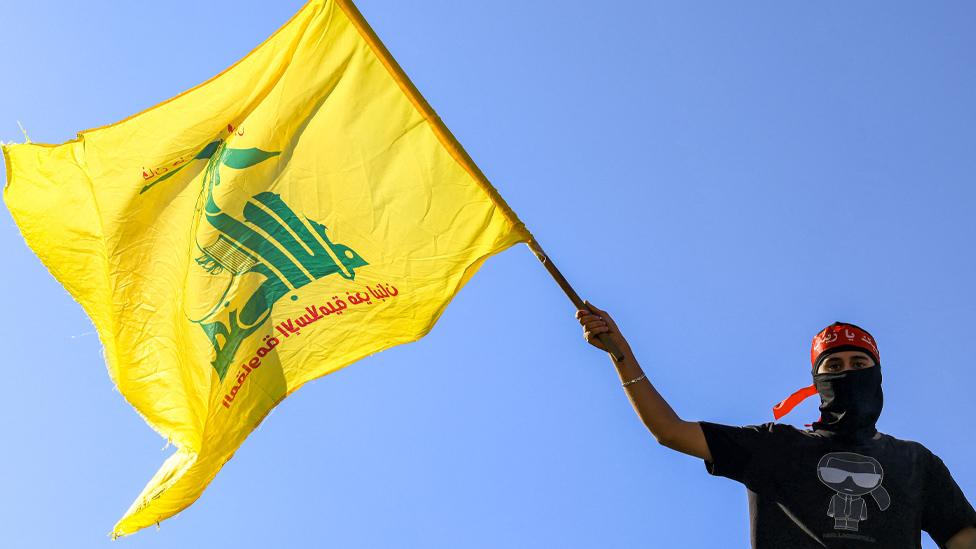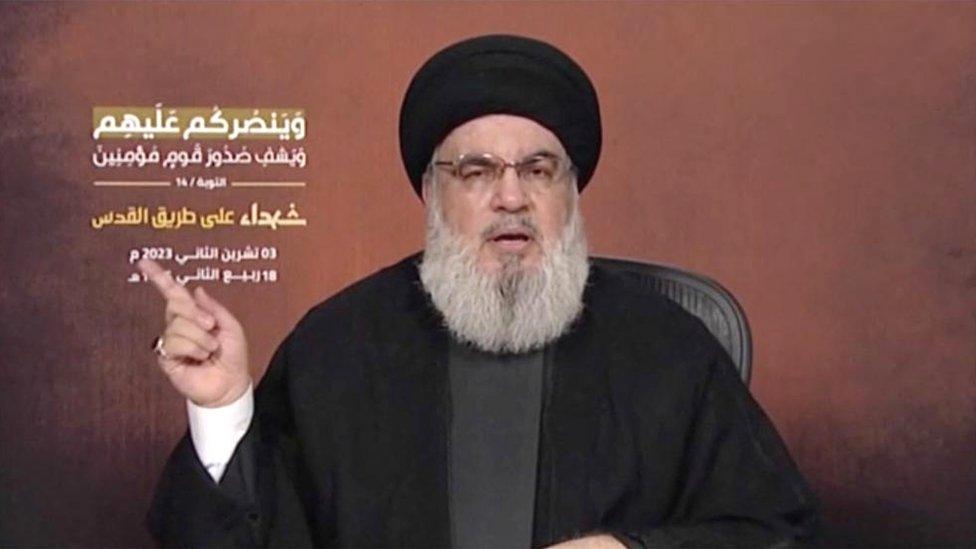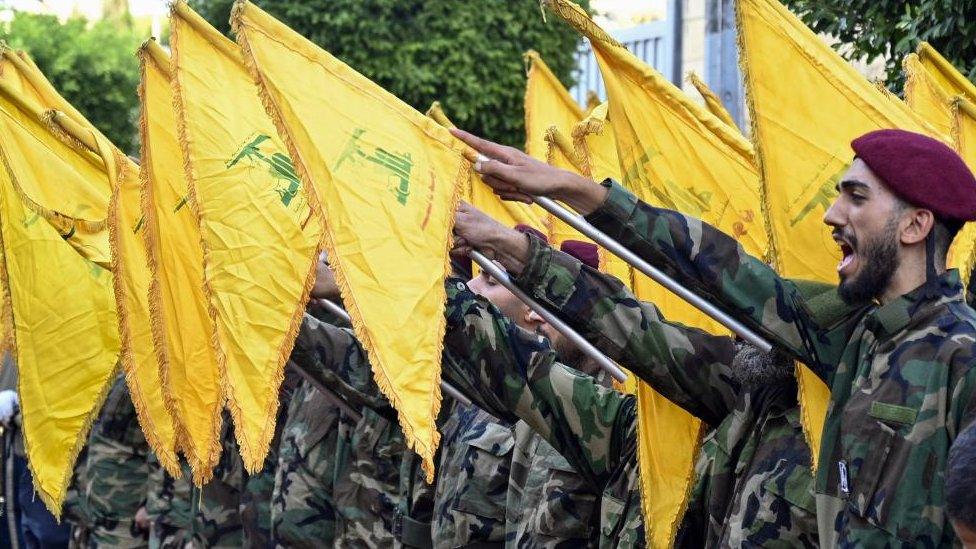What is Hezbollah and why has it been fighting Israel in Lebanon?
- Published

Hezbollah is a Shia Muslim political and military group in Lebanon which has been involved in a series of violent conflicts with Israel.
It has strong backing from Iran and opposes Israel's right to exist. The group is considered a terrorist organisation by Israel and many other nations, including the UK and US.
The latest Hezbollah-Israel conflict erupted in October 2023, when Hezbollah began firing rockets over the frontier after the start of the Gaza war, in solidarity with its ally Hamas. Israel responded with strikes.
The conflict escalated further in September 2024, when Israel said it wanted tens of thousands of people forced from their homes by Hezbollah rocket attacks to be able to safely return. It began a campaign of wide-ranging air strikes against Hezbollah, followed by a ground invasion of southern Lebanon.
The conflict has left Hezbollah severely weakened.
The offensive killed around 4,000 people in Lebanon, including many civilians. More than a million people have been displaced in Lebanon since 8 October 2023.
Israel says 45 Israeli civilians and 75 soldiers were killed in the conflict to November 2024, external.
A ceasefire agreement announced on 27 November requires both Hezbollah and Israeli forces to leave southern Lebanon. The initial deadline of 26 January was extended until 18 February.
What is Hezbollah and what are its aims?
Hezbollah emerged out of Shia militias formed to resist Israel after its invasion of southern Lebanon in 1982, during Lebanon's 1975-1990 civil war.
Its name means "Party of God" in Arabic.
Officially announcing its existence in 1985, Hezbollah called for an Islamic government in Lebanon. It declared that its confrontation with Israel "should only end when it has been removed from existence".
The group's attacks on Israeli forces are widely considered in Lebanon to have been instrumental in Israel's decision to end its 18-year-long occupation in 2000. The date Israeli forces left is a public holiday in Lebanon, called Resistance and Liberation Day.
Afterwards, Hezbollah resisted pressure to disarm and maintained a significant military presence in the south of Lebanon.
The group, and the Lebanese government, refused to accept the UN's finding that the Israeli withdrawal was complete, saying disputed border areas were still occupied. Sporadic exchanges of fire with Israeli forces continued.
In July 2006, Hezbollah fighters launched a deadly cross-border attack, triggering a massive Israeli response. More than 1,125 Lebanese, most of them civilians, died during the 34-day war, as well as 119 Israeli soldiers and 45 civilians.
The next month, the UN Security Council unanimously passed Resolution 1701, external, which ended the war and created a buffer zone between Israel and Lebanon. The current ceasefire deal also uses this agreement as its basis.
It demanded that non-state armed groups in Lebanon disarm and pull back about 30km (19 miles) north of the Blue Line, the unofficial border between Lebanon and Israel, in line with the Litani River.
It said this area "should be free of any armed personnel, assets and weapons other than those of the Lebanese authorities and UN peacekeepers".
However, Hezbollah, which had declared victory, did not comply and went on to build extensive infrastructure in the area.
Lebanon says Israel's violations of the resolution have included military flights over its territory.
Hezbollah also continued to upgrade and expand its arsenal. With Iranian funding, training and weapons, its forces became stronger than those of the Lebanese army.
In 2009, the group issued a new political manifesto in which it dropped the reference to an Islamic government but rejected "any compromise with Israel or recognising its legitimacy".
Its fighters also became battle-hardened in neighbouring Syria's civil war. By 2013, they were helping then-President Bashar al-Assad's government turn the tide against rebel and jihadist forces.
Hezbollah has also been accused of carrying out a string of bombings and plots against Jewish and Israeli targets outside Lebanon.
Who are Hezbollah's leaders?

Hassan Nasrallah was a Shia cleric who led Hezbollah from 1992 until his death in 2024
Many of Hezbollah's most senior military and political leaders were killed during the latest conflict with Israel.
Hezbollah was led by Hassan Nasrallah, a Shia cleric, from 1992 until his death in an Israeli air strike in September 2024. Nasrallah had played a key role in turning Hezbollah into a political force, as well as a military one.
He was revered by Hezbollah supporters and had close links with Iran and its Supreme Leader, Ayatollah Ali Khamenei.
Despite being one of the best known and most influential figures in the Middle East, Nasrallah had not been seen in public for many years, to avoid being targeted by Israel.
Following his death, Hezbollah announced in late October that its deputy secretary general Naim Qassem would become its new leader.
Other senior figures killed in Israeli attacks include cleric Hashem Safieddine, who had been expected to replace Nasrallah.
How strong are Hezbollah's forces?
Hezbollah's current military strength is difficult to assess as it has suffered heavy losses.
Before the ceasefire was announced in November, much of its infrastructure was destroyed, its weapons arsenal was depleted and hundreds of fighters killed.
The overthrow of Bashar al-Assad in Syria is also seen as a significant blow to Hezbollah. Syria, under Assad, played an important role in Hezbollah's connections to Iran and it was a key staging post for the transfer of weapons and ammunition to the group.
Previously, Hezbollah had been considered one of the most heavily armed, non-state military forces in the world.

In 2021, the group claimed to have 100,000 fighters, although independent estimates put the number between 20,000 and 50,000.
Before the conflict with Israel escalated, it was estimated to have 120,000-200,000 rockets and missiles, according to the Center for Strategic and International Studies, external think tank.
Most of this arsenal was made up of small, unguided, surface-to-surface artillery rockets. It was also thought to have anti-aircraft and anti-ship missiles, as well as guided missiles capable of striking deep inside Israel.
How much support does Hezbollah have in Lebanon?
The war with Israel has also led to a political shift in Lebanon.
A new president, Joseph Aoun, was appointed in January 2025, after the country spent more than two years without one.
Aoun was the head of Lebanon's army and he was selected despite Hezbollah preferring another candidate. He has pledged to work to ensure that the Lebanese state has "the exclusive right to bear arms" - a direct reference to Hezbollah.
In addition, a post-war cabinet named by the new prime minister, Nawaf Salam, excludes Hezbollah. However, it is split evenly among Lebanon's religious groups and Hezbollah's ally, Amal, was allowed to choose four ministers.
New US Middle East envoy Morgan Ortagus has warned that the Trump administration has "clear red lines" that Hezbollah will not be tolerated as a part of the government.
Before the war, Hezbollah - along with other political groups - was already constrained by Lebanon's many problems, including one of the world's worst economic crises and political corruption. No group ran the country and there had been no functioning government since elections in 2022.
However, although the country was deeply divided over Hezbollah, it had considerable influence, with a seat in every previous cabinet formed since 2005 and a network of social services including schools and healthcare facilities.
It also enjoyed substantial popular support from those who saw it as a resistance force against Israel.
In a country where religious identity strongly impacts people's politics, many of Hezbollah's supporters have traditionally been Shia Muslims, while many of its critics and opponents are non-Shia.